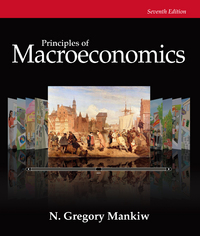Question
Adverse Selection Problem It is March 2020 and there is evidence of people getting sick from an unknown virus.Only 2 percent of the population have
Adverse Selection Problem
It is March 2020 and there is evidence of people getting sick from an unknown virus.Only 2 percent of the population have visible symptoms; they require hospitalization and are known to have the virus. Another 10 percent of people are infected with the virus but are asymptomatic and do not know they are infected. The remaining 88 percent of the population are not infected with the virus.As of March 2020, there is no test to determine whether an asymptomatic person has the virus. Hospitalization costs are $40,000 on average. In the U.S., anyone who is hospitalized cannot buy health insurance because they already have the condition. These unlucky few must pay for healthcare out of their own pocket.
Asymptomatic patients have a 50 percent chance of needing hospitalization. Uninfected patients have a 10 percent chance of eventually needing hospitalization.People who do contract the virus but who do not require hospitalization eventually recover at home and thus do not use insurance. Both the asymptomatic and uninfected population groups want to get insurance as soon as possible. (For ease of calculation,you canemploy the10% and 88%values asthey are;that is,you do not need tore-normalize /adjustthese values to account forthe fact that2%of thetotal populationhasa knowninfectionand thus is not inconsideration, as they cannotobtain insurance).
HINT:ReviewVideo 4in the week's course to understand how to do these calculations. No Insurance Case & Infected scenario
- No information scenario
If you assume that both uninfected and asymptomatic patients want to buy insurance, how much would an insurance company in a competitive market charge for expected costs? Neither the insurance firms nor the prospective patients know who is infected and asymptomatic or uninfected.
Question 1: No Insurance Case & Infected scenario
What is the expected cost to someone who has the virus, visible symptoms, and needs hospitalization?
Question 2 : No information scenario
If you assume that both uninfected and asymptomatic patients want to buy insurance, how much would an insurance company in a competitive market charge for expected costs? Neither the insurance firms nor the prospective patients know who is infected and asymptomatic or uninfected?
Full information scenario (Questions 3-4)
Suppose that a test becomes available that can tell definitively whether an asymptomatic person has the virus. The test can also tell if a person is uninfected. Assume the government will pay for the test so neither patients nor insurance firms need to pay for it. What are the prices of insurance offered in the market:
Question 3:
For uninfected patients, the price is:
Question 4:
For asymptomatic infected patients, the price is:
Asymmetric information scenario (Questions 5-9)
Suppose that, before the test becomes available, asymptomatic patients themselves can determine whether they have the virus because they cannot taste strawberries. People who can taste strawberries don't have the virus. Otherwise, there are no outwardly visible signs, and people who can and cannot taste strawberries can easily lie, so both can claim that their taste is fine.
Question 5
Since asymptomatic patients can easily lie about their tastebuds, insurance firms still have no data about who is uninfected and who is infected and asymptomatic. From their perspective, what is the expected cost of offering insurance to uninfected and infected and asymptomatic patients?
Question 6
At the expected average insurance cost in Question 4, what can be said about the insurance contract that the uninfected patients will purchase? (Choose best answer):
They will actually buy a contract for $5400
They will actually buy a contract for $5520
They will not pay $5520 and will exit the market
They will actually buy a contract for $4200
Question 7:
The choice of the uninfected patient is best described as? (Choose best answer):
Moral Hazard
Signaling
Lemons Market
Private Insurance Market
Question 8 :
Screening
It becomes known that the asymptomatic cases will mature into symptomatic cases within 14 days. Symptoms appearing within the 14 days will void the insurance contract. Which of the following is the likely new insurance contract offered in the market by the insurance firms (choose best answer):
A single contract priced at $4,000
A single contract priced at $5,520
A single contract priced at $20,000
A $20,000 and a $4,000 contract where the high-priced contract only provides coverage after 14 days
A $20,000 and a $4,000 contract where the low priced contract only provides coverage after 14 days
Question 9 :
Signaling
Suppose that uninfected patients have a 1 percent chance of becoming infected and symptomatic in 10 days, in which case they are on their own for coverage [expected costs would be (.01)($40,000)=$400]. A new test is developed that will prove the presence or absence of the virus. It costs $20, and the government will not pay for it. Which option best describes the choice of patients in the market (choose best answer):
Uninfected patients pay out-of-pocket to take the test
Asymptomatic patients pay out-of-pocket to take the test
Both uninfected patients and asymptomatic patients pay to take the test
The insurance firms pay to test patients so they can offer $4,000 and $20,000 contracts
The insurance firms pay to test patients so they can offer a $5,520 contract
The insurance firms pay to test patients so they can offer $4,000, $5,520 and $20,000 contracts
Step by Step Solution
There are 3 Steps involved in it
Step: 1

Get Instant Access to Expert-Tailored Solutions
See step-by-step solutions with expert insights and AI powered tools for academic success
Step: 2

Step: 3

Ace Your Homework with AI
Get the answers you need in no time with our AI-driven, step-by-step assistance
Get Started


